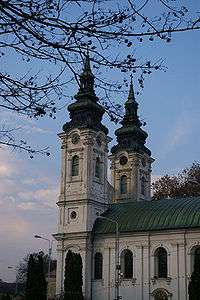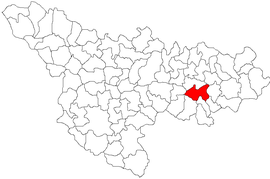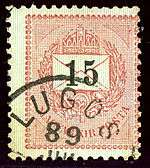Lugoj
Lugoj (Romanian pronunciation: [ˈluɡoʒ]) is a city in Timiș County, Banat, western Romania. The river Timiș divides the city into two halves, the so-called Romanian Lugoj that spreads on the right bank and the German Lugoj on the left bank. The city administers two villages, Măguri (Hungarian: Szendelak) and Tapia (Hungarian: Tápia).
Lugoj Lugos Lugosch | |
|---|---|
 Baroque Orthodox Cathedral | |
 Coat of arms | |
 Location in Timiș County | |
 Lugoj Location in Romania | |
| Coordinates: 45°41′10″N 21°54′2″E | |
| Country | |
| County | Timiș |
| Government | |
| • Mayor | Francisc Boldea[1] (PSD) |
| Area | 88.05 km2 (34.00 sq mi) |
| Elevation | 124 m (407 ft) |
| Population (2011)[2] | 40,361 |
| • Density | 460/km2 (1,200/sq mi) |
| Time zone | EET/EEST (UTC+2/+3) |
| Postal code | 305500 |
| Vehicle reg. | TM |
| Website | www |

History


Lugoj was once a strongly fortified city that developed along the river Timiș. During the Middle Ages and eighteenth century, it was of greater relative importance than at present.
A diploma dated Wednesday 22 August 1376, signed by King Sigismund of Luxemburg, shows that Lugoj city was donated to the Losonczy family. At the end of the 14th century, after the Battle of Nicopolis (1396), the Turks crossed the Danube, invading the region of Banat and reached the gates of Lugoj. The city's defense system was strengthened with trenches, ramparts, and palisades in 1440, by initiative of John Hunyadi, the comes of Temes County. It resisted Ottoman pressures until 1658, when Ákos Barcsay, the Prince of Transylvania, asked the cities of Lugoj and Caransebeș to accept the decision taken by the Diet of Sighișoara to agree to Turkish occupation.
After the defeat of the Turks at the Battle of Vienna in 1683, the Habsburgs went on the offensive and briefly occupied the cities of Lugoj and Lipova (1688). On September 25, 1695 the battle between the armies of the Habsburg Monarchy and the Ottoman Empire that took place near Lugoj ended with the defeat of the Austrians.
After the Treaty of Karlowitz (1699), the region of Banat remained under Ottoman rule for nearly 20 years. Once the Treaty of Passarowitz was signed on 21 July 1718, the Turks were expelled. Subsequently, the Habsburg Monarchy wanted to repopulate the Banat, which had emptied to a considerable extent following the years of occupation and the earlier bubonic plague. The government recruited Germans from Bavaria, Swabia, Alsace, and Lorraine, particularly farmers to revive agriculture in the rich floodplain. The immigrants traveled down the Danube River on boats to this area. They later took the rafts apart to use them to build their first houses. In this area, the first German colonists settled on the left bank of the river Timiș around 1720, creating what was called "German Lugoj". The government had offered them the privileges of keeping their German language and religion; most were Roman Catholic.
In the 18th century, many public buildings were built in the city, including the Roman Catholic Church and the Orthodox Church "Assumption". In 1778, following the incorporation of Banat into Hungary, Lugoj became the seat of Krassó (Caraș) County. In 1795 the government unified the Romanian Lugoj and the German Lugoj.
In the summer of 1842 a great fire took place, in which about 400 houses and important buildings were destroyed.
Eftimie Murgu settled in Lugoj in 1841. In June 1848 he chaired the second National Assembly of Romanians of Banat, where they expressed in postulates the National Order of Romanians during the Revolutionary Movement from Banat, whose center was Lugoj. In August 1849 Lugoj was the last seat of the Hungarian revolutionary government. It served as the last refuge of Lajos Kossuth and several other leaders of the Revolution prior to their escape to the Ottoman Empire.
Under the imperial resolution of 12 December 1850, Lugoj became the seat of the Greek-Catholic Diocese of Banat. Lugoj was the seat of Krassó-Szörény County from 1881 to 1918. The Iron Bridge, a symbol of Lugoj, was built in 1902. The famous Dracula actor Bela Lugosi was born Béla Blaskó in this town in 1888; he took the name "Lugosi" in 1903 to honor his birthplace.[3]
On November 3, 1918 a Great National Assembly took place in Lugoj. The right of self-determination of the Romanian nation was proclaimed after the dissolution of Austria-Hungary at the end of World War I. The region of Banat, after a brief period of Serbian occupation came under Romanian administration. Severin County was established in 1926, and its seat was located in Lugoj, disbanded with the administrative reform of 1938, re-created in 1940, and finally disbanded with the temporary abolition of counties in 1950 by the Communist government.
During the Romanian Revolution of 1989, Lugoj saw protests during which three men died. It became the second place in the country, after Timișoara, where the communist regime fell.[4][5]
The city is the seat of the Eparchy of Lugoj in the Romanian Church United with Rome, Greek-Catholic.
Jewish history
Jews first settled in the town in the early 18th century, working in manufacturing and in running the transport system. They eventually adhered to the Neolog movement; a Jewish school was founded in 1883. Many Jews left at the end of World War I and the beginning of Romanian rule. Zionist activity began in 1919. In 1930, there were 1418 Jews, accounting for 6% of the population.[6]
During World War II, the Ion Antonescu regime economically sanctioned the Jews, sending male members of the community to forced labor camps near the Olt River and to the Brașov area. Four youths aged 14–15, charged with illegal communist activity, were sent to the Transnistria Governorate, where they died. Many Jews left after the war, mainly to Palestine.[6]
Population and demographics
| Historical population of Lugoj[7] | |||||||||||||
| Year | Population | Romanians | Hungarians | Germans | |||||||||
|---|---|---|---|---|---|---|---|---|---|---|---|---|---|
| 1880 | 12,389 | 46.8% | 11.6% | 36.9% | |||||||||
| 1890 | 13,548 | 46% | 13.8% | 38.3% | |||||||||
| 1900 | 17,486 | 37.9% | 22.7% | 35.9% | |||||||||
| 1910 | 20,962 | 34.9% | 32.9% | 29.5% | |||||||||
| 1920 | 21,172 | 41.2% | 20.1% | 28.3% | |||||||||
| 1930 | 24,694 | 43.3% | 21.9% | 24.9% | |||||||||
| 1941 | 27,871 | 51.6% | 17% | 21.7% | |||||||||
| 1956 | 31,364 | 63.4% | 17.8% | 13.6% | |||||||||
| 1966 | 36,728 | 68% | 16.3% | 12.4% | |||||||||
| 1977 | 44,537 | 72.6% | 13.8% | 10.7% | |||||||||
| 1992 | 50,939 | 79.8% | 10.7% | 5.2% | |||||||||
| 2002 | 44,636 | 83% | 9.6% | 3% | |||||||||
| Detailed Demographics – 2011 | |||||||||||||
| Ethnic group | Number | Percentage | |||||||||||
|---|---|---|---|---|---|---|---|---|---|---|---|---|---|
| Romanians | 32,036 | 85.83% | |||||||||||
| Hungarians | 2,727 | 7.3% | |||||||||||
| Germans | 744 | 1.99% | |||||||||||
| Roma | 905 | 2.42% | |||||||||||
| Ukrainians | 508 | 1.36% | |||||||||||
| Other | 398 | 0.6% | |||||||||||
| Total | 37,321 | 100% | |||||||||||
Senior High and Post-secondary Education

- Coriolan Brediceanu National College
- Iulia Hașdeu National College
- Aurel Vlaicu School Group
- Valeriu Braniște College
- Drăgan European University of Lugoj
Natives
- Simona Arghir, handballer
- Filaret Barbu, operetta composer
- Gelu Barbu, ballet dancer and choreographer
- Caius Brediceanu, diplomat
- Coriolan Brediceanu, politician and lawyer
- Tiberiu Brediceanu, composer
- Corina Caprioriu, judoka
- Aurel Ciupe, painter
- Konstantin Danil, portraiture painter
- Georges Devereux, ethnopsychologist
- Iosif Constantin Drăgan, businessman and author
- Traian Grozăvescu, opera tenor
- Sepp Helfrich, Austrian National Socialist
- August Kanitz, botanist
- György Kurtág, composer
- Bela Lugosi, actor
- Lavinia Miloșovici, gymnast
- Victor Neumann, historian
- Dumitru Pârvulescu, wrestler
- Aurel Popovici, politician
- Ioan Popovici-Bănățeanul, writer and poet
- Josef Posipal, soccer player
- Michael Redl, handball player and coach
- Otilia Ruicu-Eșanu, 400m athlete
- Béla Szende, politician
- Aura Twarowska, mezzo-soprano
- Koloman Wallisch, labor leader
International relations
Twin towns — Sister cities
Lugoj is twinned with:
References
- "Results of the 2016 local elections". Central Electoral Bureau. Retrieved 3 April 2020.
- "Populaţia stabilă pe judeţe, municipii, oraşe şi localităti componenete la RPL_2011" (in Romanian). National Institute of Statistics. Retrieved 4 February 2014.
- Franklin Ruehl (3 November 2011). "15 Intriguing Halloween-Related Factoids!". Huffington Post. Retrieved 9 August 2020.
- Stefan Both (December 22, 2019). "Cum a ajuns Lugojul al doilea oraş 'liber de comunism' din România". Adevărul (in Romanian).
- Ioan Sebastian Jucu (2008). "A short analysis on the street names from Lugoj – comparative approach before and after 1990" (PDF). Review of Historical Geography and Toponomastics. III (5–6): 73.
- Shmuel Spector, Geoffrey Wigoder (eds.), The Encyclopedia of Jewish Life Before and During the Holocaust: K—Sered, p. 764. New York University Press, 2001, ISBN 0-8147-9377-0
- Erdély etnikai és felekezeti statisztikája
External links
| Wikimedia Commons has media related to Lugoj. |
| Wikivoyage has a travel guide for Lugoj. |
